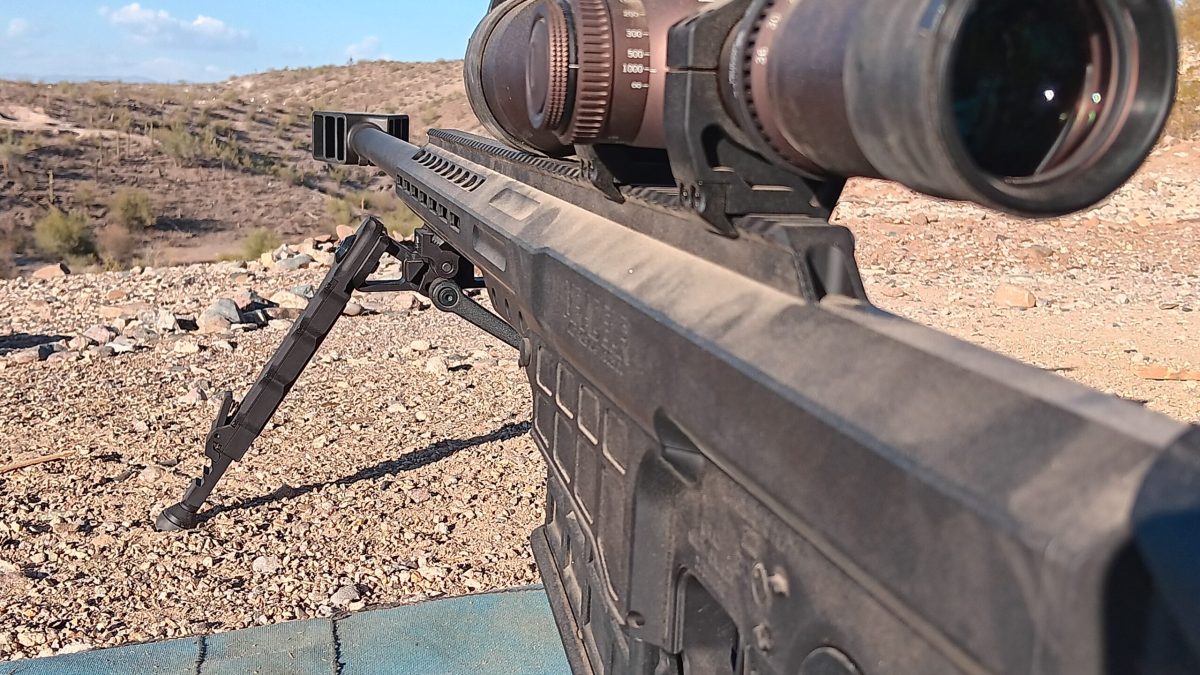Photos by Kenda Lenseigne
The numbers don’t lie. 2,760 feet per second. About what you could expect from a 6.5 Creedmoor, lobbing a 140-grain bullet, with a .310 G7 ballistic coefficient.
The MRAD ELR’s projectiles exit its barrel right about the same speed, but the other numbers are different.
Those digits are why the gun was designed. While the Barrett’s muzzle velocity is nothing remarkable, the mass, length, and aerodynamics of its 500-grain A-tip bullet means it can, and has, hit targets out to two miles.
In terms of sheer weight, the rifle is probably the biggest we’ve ever featured in RECOIL, and its presence is imposing — there’s no mistaking it for anything other than a means to deliver enormous energy at will on distant targets, but despite its intimidating demeanor, it’s actually a bit of a pussycat to shoot — so long as you’re directly behind it. Stand next to that gigantic muzzle brake, and you’ll wish you’d chosen someplace else to be when the shooter presses the trigger.
SPECS BARRETT MRAD ELR
- Caliber: .416 Barrett
- Capacity: 5 rounds
- Barrel Length: 36 inches
- Overall Length: 62 inches
- Weight (as pictured): 39 pounds
- MSRP: $11,400
AMMO: .416 Barrett 500gr Hornady A-TIP
- Manufacturer: Barrett
- Cartridge: .416 Barrett
- Bullet Type: Hornady A-Tip
- Bullet Weight: 500 grain
- Muzzle Velocity: 2850 ft/s
- G7 Ballistic Coefficient: 0.492
UNDER THE HOOD
Let’s start with that brake. Measuring 4 inches at its widest part, there are three baffles to redirect gases escaping from the muzzle, which get progressively wider in order to give the greatest amount of surface area to push against. It stands 2 inches tall, and despite its gargantuan dimensions, actually looks perfectly proportioned to the rest of the gun. It’s threaded and clamped to the barrel,and removable, should you want to mount up a suppressor, and there’s an option of a shorter barrel to mitigate the added length of a can.
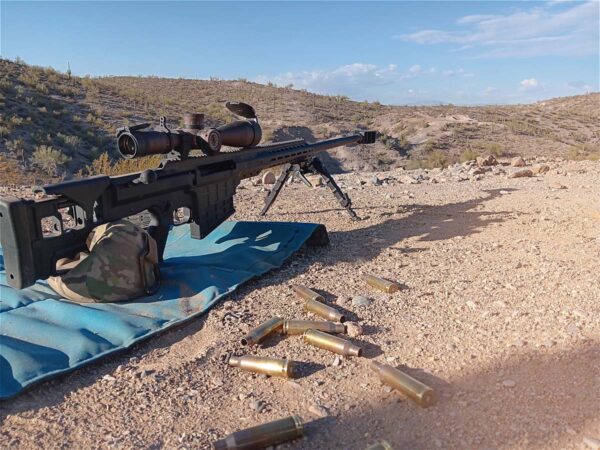
The MRAD ELR’s barrel is 36 inches long and 1.1 inches in diameter at the far end. While it may look like it came off an M2 HB, this is no bullet hose, rather it’s stainless steel and hand-lapped after being painstakingly rifled with a single point tool, like some of the very finest benchrest barrels. At the breech end, the barrel threads into a barrel extension, which sets headspace, much like America’s favorite semi-auto, but this one is in proportion with the .416 round and is as enormous as you’d think.
If you’re familiar at all with the MRAD’s architecture, you’ll see it echoed in its big brother, where the long barrel tenon is clamped by the upper receiver by crossbolts — two in the case of the MRAD, three in the MRAD ELR. So long as you have an IP30 Torx-Plus wrench and an elbow calibrated to 140 in-lb, you can swap barrels in the field at end user level. And if you feel the need to change calibers also, well that’s covered, too.
Unlike most bolt-action designs, the MRAD family use a bolt, which would be more at home on an artillery piece, with an interrupted Acme-style thread, giving ample strength to handle the biggest cartridges.
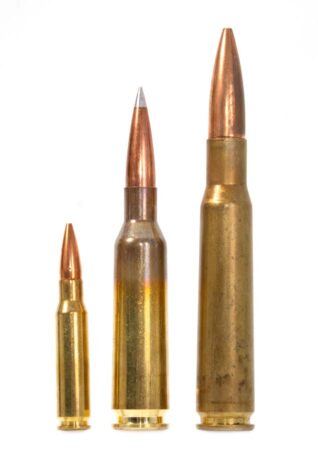
It has the added benefit of providing primary extraction independent of a bolt handle cam path, as it’s built into the locking lugs — we’d expect the extractor to pull through the rim before declaring a case to be stuck, and would have no concerns about hammering on the bolt handle to free up a problem shell. The extractor itself is Sako-pattern and set into the largest of the lugs, while the ejector is an M16-style plunger.
Swapping bolt heads is as easy as lifting up a lever in the 1.25-inch diameter bolt body and pulling the existing one forward, while replacement is just as simple. In order to reduce friction and wear on the upper receiver, the ELR’s bolt rides in a polymer sleeve, which has its own little cutout in the Pelican case in which the gun ships. Because this is one of those items that’s inevitably prone to being misplaced at the worst possible time, especially when the user is cold, wet, and tired, we wanted to see if the gun would run without it. It did, though feeding wasn’t as smooth as when it was present.
While the ELR’s upper receiver may look like it’s a product of modern manufacturing techniques (and it is), there’s a very old-school methodology to its production, namely start with a massive chunk of 7000 series aluminum and hog out anything that doesn’t look like a gun.

At a guess, we’d say roughly 75 percent of the billet that enters the CNC machines winds up as chips, but the upside to this is a receiver that’s very strong, very concentric, and accurate. It also allows for the integration of the continuous, 10 MOA Picatinny top rail into the receiver, with no screws or pins to fail, and plenty of space to add clip-on night vision devices, without resorting to a bridge.
In a further departure from typical bolt-action designs, the MRAD family features lower receivers, much like an AR-15. This offers a few advantages and one notable drawback. Like an AR, there’s a lot of modularity to be found, and end users can swap out the pistol grip and trigger pack by undoing a couple of fasteners, as well as swapping over the safety from left to right side. The lower incorporates the buttstock, which as you’d expect is fully adjustable for length of pull, buttplate and comb height, and has a bag rider attached by means of a Pic rail, so the addition of a monopod is a simple affair.
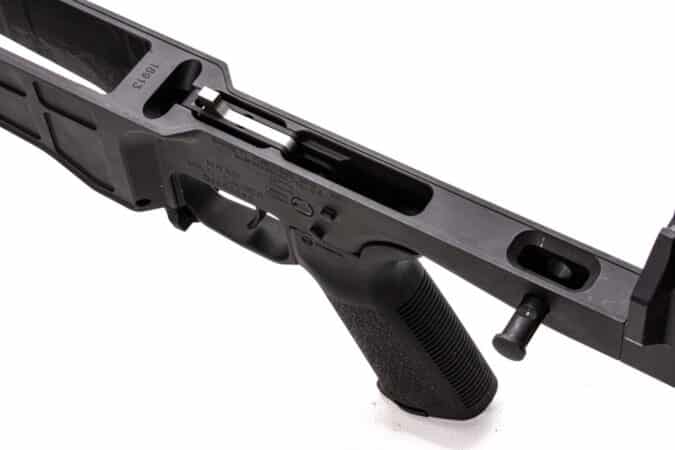
The lower attaches to the upper by means of a pair of captive push pins (sound familiar?), and it’s this system that causes the drawback mentioned earlier. Due to manufacturing tolerances, while the upper to lower fit can be made pretty tight, in order to maintain parts interchangeability there’s still going to be a slight amount of slop between them.
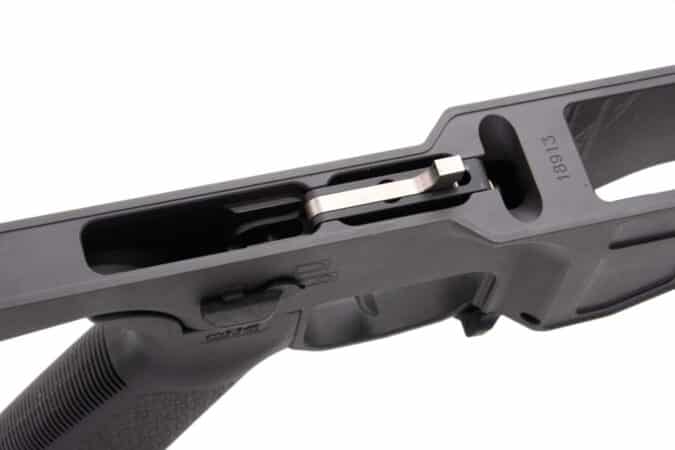
As the sear is in the lower and the firing pin in the upper, for safety this necessitates a little more sear engagement than might be the case with a conventional design, and as a result, the trigger pull has a tiny bit of creep to it. It’s not bad by any means, and if you prefer a rollover break, rather than the proverbial glass rod, then it should be your cup of Earl Grey, but if you’re used to a clean, 6-ounce pull, it’ll take some getting used to.
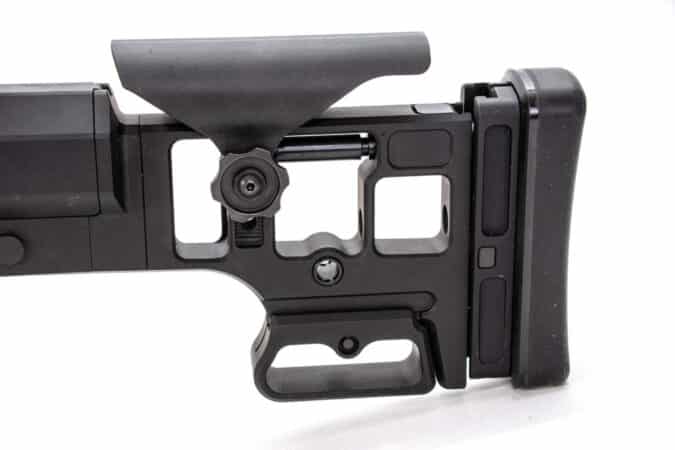
Feeding the beast is courtesy of five-round, single-column, single-feed magazines, which are tailored to the .416 Barrett cartridge. Like the rest of the gun, they’re suitably massive, with reinforcing ribs molded into their surfaces to increase strength. And yes, we did drop them in the course of our time with the gun. They held up just fine.
Although the ELR ships with an Accu-Tac bipod in the case, we wanted to try out a new support device from our friends at Spartan Precision. The HE-01 is an evolution of the Hoplite mini tripod, and while it looks strange at first to an audience used to just two legs hanging below a rifle, it’s actually a big improvement in terms of stability.
Made of 7075 aluminum and carbon fiber, it offers adjustability in both leg length and angle — from the fully extended to fully collapsed positions, offers a 10-inch spread, more than double that of a conventional bipod, and can be quickly attached and detached via either Pic or Arca rail. Cant and swivel functions are taken care of via a ball head with adjustable tension, so adjustability is almost limitless. Yes, it’s expensive, but we like nice things.
ROUNDS DOWNRANGE
Full disclosure: We didn’t wind up with a pile of brass at the end of this review, mainly because the MRAD ELR is chambered in 10-dollar bills. On its debut range day, we did a one-round zero (0.75 mils right, 1.0 mils down on the top-of-the-line Vortex Razor HD ) and then — no messing around — went straight to a mile. Dialing in a swagged 16 mils, and with a slight crosswind canceling out any spin drift, we held dead on the target.
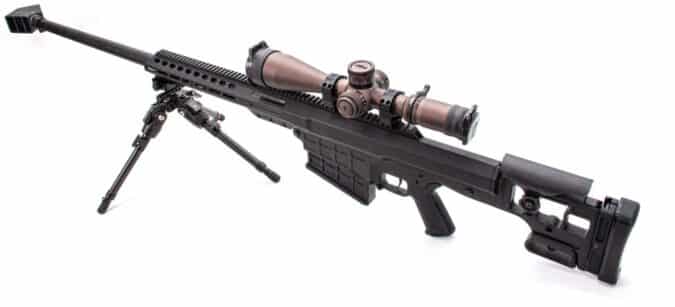
Due to foggy conditions, it took a couple of shots before we could see splash, but once observed, we quickly ran the bolt, held the spot on the reticle where the impact occurred, and sent it. Five shots from pulling the gun out of the case to rounds on target at a mile is a pretty good indication of the weapon system’s capabilities, and how easy it is to shoot.
After shooting at our CANCON event at Clinton House Plantation in South Carolina, the gun made its way to Arizona, where it was shot in the desert in balmy winter temperatures.
Bullet precession is very much a thing when it comes to big bores, so we passed up the 100-yard zero range and shot for groups at 1,000 instead. Fortunately, the local range had just painted its long-range steel collection, so in calm conditions, we printed first one 4-inch group, then a 5-inch group, and then a 4.5-inch group.

The MRAD ELR made it ridiculously easy, due mainly to the 0.976 G1 BC of the 500-grain A-Tip, not because it arrived at 1,970 fps and carrying 4,300 ft-lb of energy, but because it was barely pushed around by any stray air movements.
Forty rounds disappear very quickly when someone else is paying for it, and realizing there was only two left in the last magazine, we invited a couple of guys from the next bay over to finish off the day. They’d been working on dinging steel at medium distances with their ARs, so being well-adjusted American males, leaped at the chance to shoot the Barrett. “Hold point 5 mils left,” we advised. Boom, smack, smiles, and high-fives.
Would we buy one? If the better half wouldn’t murder us in our sleep for dropping 11 grand on a bolt gun, sure. The level of engineering prowess and attention to detail is amply evident, and who wouldn’t want a rifle capable of hitting a pickup truck, two miles away? Besides, this is still America. And we’ll buy whatever we damn well want.
Read the full article here

